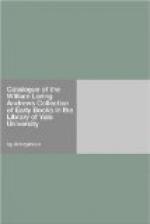Quarto. Sign. Aa^4, A^6, B^4, C-X, AA-NN^{8, 4 (altern.)}, OO^6, PP^{5}+{1}. 218 leaves, gothic letter, 34 lines (marginal citations 60 lines) to the page, without foliation. Title cut in large lower-case letters on block 2 x 4 in. Five- and six-line initials at the head of the larger divisions of the text. Ten woodcuts, one repeated. The final blank PP. 6 has been replaced by an independent leaf having on the one side the title repeated with woodcut, and on the other the printer’s device, either of which may in the binding be made the recto. The device is the first of his so-called “Sagittarius” forms, and the one most commonly used from 1506 to 1518. Ames-Dibdin, ii, p. 103. Morgan Cat. iii, p. 214, n. 743.
The present copy lacks the first four leaves, containing the title and the table of contents; but both the title and the woodcut accompanying it are repeated elsewhere in the volume, the title on fol. 218^a, the woodcut on fol. 87^a.
Of the French original, L’ordinaire des chrestiens, at least six editions were printed before 1500, the earliest apparently at Rouen, c. 1487. In them it is stated that the writing was commenced 22 May, 1467 and finished (consomme) 22 May, 1469. The corresponding dates in the prologue and epilogue of the translation are “fyrst begonne to be wryten” 14 Jan., 1467, “fyrst consumed” 14 Jan., 1500. The confusion, common to both the French and the English of the 15th century, in the derivatives of consummare and consumere relieves the translator, Andrew Chertsey, from the appearance of an over-literal translation, but the change in the date of the completed work can hardly be in the direction of accuracy.
The woodcuts which appeared in the first edition of the “Ordinary” printed in 1502 are in this second edition replaced by others of different design and better execution, borrowed mainly from “The crafte to lyve well and to dye well”, printed by de Worde in 1505 and like the present work translated by Chertsey from a French original, L’art de bien vivre et de bien mourir. Two of these illustrations, “Temptation to Impatience” (fol. 73^b) and “Soul leaving the Body” (fol. 218^a), are copied from the early block-book Ars moriendi.
Bound by Alfred Matthews in blind-tooled crimson morocco, with inside gold borders and gilt edges. Leaf 8-1/4 x 5-3/4 in.
Wynkyn de Worde, Caxton’s assistant, was a native of Woerth, Alsace. He came into possession of his master’s printing materials on his death in 1491 and continued to occupy his house in Westminster until 1500 when he moved to Fleet Street within the city. In the number of his books, almost eight hundred, he surpassed all the early printers, but many of them were works of small size and consequence. Some of his largest and finest books were reprints of Caxton’s folios. Mention has been made of his use of Caxton’s original device without addition. In all of his own various devices also, the place of honor in the center is given to Caxton’s initials and cipher, plainly as a mark of loyalty to the master, not an advertisement of himself as the successor.




